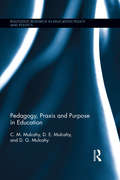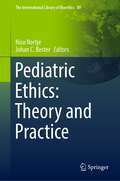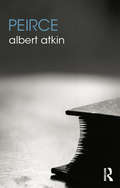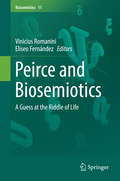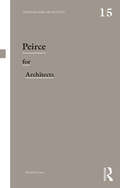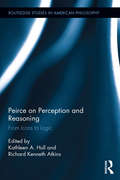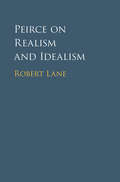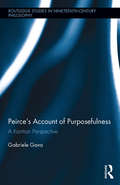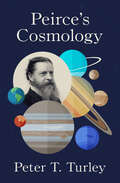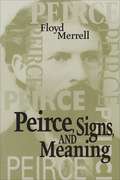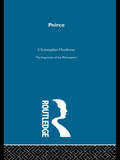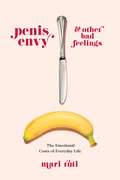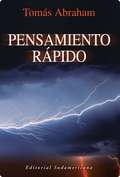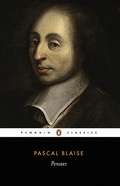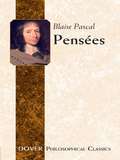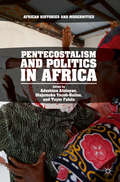- Table View
- List View
Pedagogy, Education, and Praxis in Critical Times
by Stephen Kemmis Christine Edwards-Groves Kathleen Mahon Susanne Francisco Kirsten Petrie Mervi KaukkoThis book critically explores urgent questions that researchers, educators, and policy makers need to consider and address in order to better our understanding and capacity to transform education. Focusing on areas that underpin the empirical, theoretical, and strategic research of the Pedagogy, Education and Praxis (PEP) International Research Network, it discusses the following topics: the nature of educational praxis; research approaches that facilitate praxis and praxis development; changing cultural, social, political and material conditions affecting the educational practices of teachers; and how good professional practice in teaching, leading, and professional learning are understood and experienced. Presenting findings emerging from the Pedagogy, Education and Praxis research, the book raises new questions and offers new ways of thinking about the identified issues and themes in light of current educational concerns and the prevalence of neoliberal conditions being experienced in educational settings around the globe. It provides supporting evidence and illustrative examples to help readers understand important concepts, situations, and concerns, and brings together intellectual and cultural-historical traditions that, when considered in relation to each other, open up critical opportunities and ideas orienting readers towards future educational transformation.
Pedagogy, Praxis and Purpose in Education (Routledge Research in Education Policy and Politics)
by C.M. Mulcahy D.E. Mulcahy D.G. MulcahyRecent years have shown the growth of federal legislation and programs having a profound impact on educational policy and practice, and a decline in reliance on broadly based educational justifications. Paralleling this development has been the emergence of well-endowed and influential private foundations, and an increase in corporate influence in shaping policy. In this volume the authors consider the discourse, rhetoric, and underlying values that sustain these developments alongside those that underlie more longstanding and competing educational theories and practices. This volume highlights the importance of recognizing opposing conceptualizations of education—some more educationally productive than others— and their core values, approaches to student learning, strengths and weaknesses, and justification. The authors analyze and critique what Jane Roland Martin has referred to as ‘the deep structure of educational thought’, and seek improved educational policy and practice with particular reference to curriculum and pedagogy. It features a comparative analysis of competing discourses including autocratic control, limited personal development, and praxis.
Pedagogy: The Question of Impersonation
by Jane GallopIn this anthology, teachers and scholars examine the ways in which teaching is a performance that incorporates acts of impersonation.Drawn from a conference on classroom dynamics, this anthology explores both the personal and performative aspects of teacher-student relationships. After David Crane’s prefatory “postscript,” George Otte recommends that students pretend, writing from various perspectives; Indira Karamcheti suggests putting on race as one can put on gender roles. Cheryl Johnson gets personal by playing the “trickster,” and Chris Amirault explores the relationship between the teacher and “the good student.”While Karamcheti, Gallop, and Lynne Joyrich use theatrical vehicles to structure their essays, Joseph Litvak, Arthur W. Frank, and Naomi Scheman incorporate performance as examples. Madeleine R. Grumet theorizes pedagogy, while Roger I. Simon suggests that pedagogical roles can be taken on and off at will; Gregory Jay discusses the ethical side of impersonation; and Susan Miller denounces “the personal” as a sham.
Pediatric Ethics: Theory and Practice (The International Library of Bioethics #89)
by Nico Nortjé Johan C. BesterThis book assists health care providers to understand the specific interplay of the roles and relationships currently forming the debates in pediatric clinical ethics. It builds on the fact that, unlike adult medical ethics, pediatric ethics begins within an acutely and powerfully experienced dynamic of patient-family-state-physician relationship. The book provides a unique perspective as it interacts with established approaches as well as recent developments in pediatric ethics theory, and then explores these developments further through cases. The book first focuses on setting the stage by introducing a theoretical framework and elaborating how pediatric ethics differ from non-pediatric ethics. It approaches different theoretical frameworks in a critical manner drawing on their strengths and weaknesses. It helps the reader in developing an ability to engage in ethical reasoning and moral deliberation in order to focus on the wellbeing of the child as the main participant in the ethical deliberation, as well as to be able to identify the child’s moral claims. The second section of the book focuses on the practical application of these theoretical frameworks and discusses specific areas pertaining to decision-making. These are: the critically ill child, new and enduring ethical controversies, and social justice at large, the latter of which includes looking at the child’s place in society, access to healthcare, social determinants of health, and vaccinations. With the dynamic changes and challenges pediatric care faces across the globe, as well as the changing face of new technologies, no professional working in the field of pediatrics can afford not to take due note of this resource.
Peirce (The Routledge Philosophers)
by Albert AtkinCharles Sanders Peirce (1839-1914) is generally regarded as the founder of pragmatism, and one of the greatest ever American philosophers. Peirce is also widely known for his work on truth, his foundational work in mathematical logic, and an influential theory of signs, or semiotics. Albert Atkin introduces the full spectrum of Peirce’s thought for those coming to his work for the first time. The book begins with an overview of Peirce’s life and work, considering his early and long-standing interest in logic and science, and highlighting important views on the structure of philosophical thought. Atkin then explains Peirce’s accounts of pragmatism and truth examining important later developments to these theories. He then introduces Peirce’s full accounts of semiotics, examines his foundational work on formal and graphical logic, and introduces Peirce’s account of metaphysics, the least understood aspect of his philosophy. The final chapter considers Peirce’s legacy and influence on the thought of philosophers such as John Dewey and Richard Rorty, as well as highlighting areas where Peirce’s ideas could still provide important insights for contemporary philosophers. Including chapter summaries, suggestions for further reading and a glossary, this invaluable introduction and guide to Peirce’s philosophy is essential reading for those new to his work.
Peirce and Biosemiotics
by Vinicius Romanini Eliseo FernándezThis volume discusses the importance of Peirce´s philosophy and theory of signs to the development of Biosemiotics, the science that studies the deep interrelation between meaning and life. Peirce considered semeiotic as a general logic part of a complex architectonic philosophy that includes mathematics, phenomenology and a theory of reality. The authors are Peirce scholars, biologists, philosophers and semioticians united by an interdisciplinary endeavor to understand the mysteries of the origin of life and its related phenomena such as consciousness, perception, representation and communication.
Peirce and Husserl: Mutual Insights on Logic, Mathematics and Cognition (Logic, Epistemology, and the Unity of Science #46)
by Mohammad Shafiei Ahti-Veikko PietarinenThis volume aims to provide the elements for a systematic exploration of certain fundamental notions of Peirce and Husserl in respect with foundations of science by means of drawing a parallelism between their works. Tackling a largely understudied comparison between these two contemporary philosophers, the authors highlight the significant similarities in some of their fundamental ideas. This volume consists of eleven chapters under four parts. The first part concerns methodologies and main principles of the two philosophers. An introductory chapter outlines central historical and systematical themes arising out of the recent scholarship on Peirce and Husserl. The second part is on logic, its Chapters dedicated to the topics from Peirce’s Existential Graphs and the philosophy of notation to Husserl’s notions of pure logic and transcendental logic. The third part includes contributions on philosophy of mathematics. Chapters in the final part deal with the theory of cognition, consciousness and intentionality. The closing chapter provides an extended glossary of central terms of Peirce’s theory of phaneroscopy, explaining them from the viewpoint of the theory of cognition.
Peirce and the Conduct of Life: Sentiment and Instinct in Ethics and Religion
by Richard Kenneth AtkinsCharles Sanders Peirce (1839–1914) is regarded as the founding father of pragmatism and a key figure in the development of American philosophy, yet his practical philosophy remains under-acknowledged and misinterpreted. In this book, Richard Atkins argues that Peirce did in fact have developed and systematic views on ethics, on religion, and on how to live, and that these views are both plausible and relevant. Drawing on a controversial lecture that Peirce delivered in 1898 and related works, he examines Peirce's theories of sentiment and instinct, his defence of the rational acceptability of religious belief, his analysis of self-controlled action, and his pragmatic account of practical ethics, showing how he developed his views and how they interact with those of his great contemporary William James. This study will be essential for scholars of Peirce and for those interested in American philosophy, pragmatism, the philosophy of religion, the philosophy of action, and ethics. A rare book-length study of Peirce's practical philosophy which delves into a little-studied area of Peirce's thought. Contrasts Peirce's views with those of William James, appealing to those who have an interest in the thought of James or pragmatism more generally. Develops a detailed analysis of the increasingly popular debate on self-controlled action.
Peirce and the Threat of Nominalism
by Paul ForsterCharles Peirce, the founder of pragmatism, was a thinker of extraordinary depth and range - he wrote on philosophy, mathematics, psychology, physics, logic, phenomenology, semiotics, religion and ethics - but his writings are difficult and fragmentary. This book provides a clear and comprehensive explanation of Peirce's thought. His philosophy is presented as a systematic response to 'nominalism', the philosophy which he most despised and which he regarded as the underpinning of the dominant philosophical worldview of his time. The book explains Peirce's challenge to nominalism as a theory of meaning and shows its implications for his views of knowledge, truth, the nature of reality, and ethics. It will be essential reading both for Peirce scholars and for those new to his work.
Peirce for Architects (Thinkers for Architects)
by Richard CoyneIdeas gain legitimacy as they are put to some practical use. A study of Charles Sanders Peirce (1839-1914) supports this pragmatism as a way of thinking about truth and meaning. Architecture has a strong pragmatic strand, not least as we think of building users, architecture as a practice, the practical demands of building, and utility. After all, Vitruvius placed firmness and delight in the company of utilitas amongst his demands on architecture. Peirce (pronounced 'purse') was a logician, and so many of his ideas are couched in terms of formal propositions and their limitations. His work appeals therefore to many architects grappling with the digital age, and references to his work cropped up in the Design Methods Movement that developed and grew from the 1950s. That movement sought to systematise the design process, contributing to the idea of the RIBA Plan of Work, computer-aided design, and various controversies about rendering the design process transparent and open to scrutiny. Peirce’s commitment to logic led him to investigate the basic elements of logical statements, notably the element of the sign. His best-known contribution to design revolves around his intricate theory of semiotics, the science of signs. The study of semiotics divided around the 1980s between advocates of Peirce’s semiotics, and the broader, more politically charged field of structuralism. The latter has held sway in architectural discourse since the 1980s. Why this happened and what we gain by reviving a Peircean semiotics is the task of this book.
Peirce on Perception and Reasoning: From Icons to Logic (Routledge Studies in American Philosophy)
by Richard Kenneth Atkins Kathleen A. HullThe founder of both American pragmatism and semiotics, Charles Sanders Peirce (1839–1914) is widely regarded as an enormously important and pioneering theorist. In this book, scholars from around the world examine the nature and significance of Peirce’s work on perception, iconicity, and diagrammatic thinking. Abjuring any strict dichotomy between presentational and representational mental activity, Peirce’s theories transform the Aristotelian, Humean, and Kantian paradigms that continue to hold sway today and, in so doing, forge a new path for understanding the centrality of visual thinking in science, education, art, and communication. The essays in this collection cover a wide range of issues related to Peirce’s theories, including the perception of generality; the legacy of ideas being copies of impressions; imagination and its contribution to knowledge; logical graphs, diagrams, and the question of whether their iconicity distinguishes them from other sorts of symbolic notation; how images and diagrams contribute to scientific discovery and make it possible to perceive formal relations; and the importance and danger of using diagrams to convey scientific ideas. This book is a key resource for scholars interested in Perice’s philosophy and its relation to contemporary issues in mathematics, philosophy of mind, philosophy of perception, semiotics, logic, visual thinking, and cognitive science.
Peirce on Realism and Idealism
by Robert LaneThis book offers a new interpretation of the metaphysics of Charles Peirce (1839-1914), the founder of pragmatism and one of America's greatest philosophers. Robert Lane begins by examining Peirce's basic realism, his belief in a world that is independent of how anyone believes it to be. Lane argues that this realism is the basis for Peirce's account of truth, according to which a true belief is one that would be settled by investigation and that also represents the real world. He then explores Peirce's application of his Pragmatic Maxim to clarify the idea of reality, his two forms of idealism, and his realism about generality and vagueness. This rich study will provide readers with a clear understanding of Peirce's thoughts on reality and truth and how they intersect, and of his views on the relation between the mind and the external world.
Peirce on Signs
by James HoopesCharles Sanders Peirce (1839-1914) is rapidly becoming recognized as the greatest American philosopher. At the center of his philosophy was a revolutionary model of the way human beings think. Peirce, a logician, challenged traditional models by describing thoughts not as "ideas" but as "signs," external to the self and without meaning unless interpreted by a subsequent thought. His general theory of signs -- or semiotic -- is especially pertinent to methodologies currently being debated in many disciplines.This anthology, the first one-volume work devoted to Peirce's writings on semiotic, provides a much-needed, basic introduction to a complex aspect of his work. James Hoopes has selected the most authoritative texts and supplemented them with informative headnotes. His introduction explains the place of Peirce's semiotic in the history of philosophy and compares Peirce's theory of signs to theories developed in literature and linguistics.
Peirce's Account of Purposefulness: A Kantian Perspective (Routledge Studies in Nineteenth-Century Philosophy)
by Gabriele GavaThis book presents a systematic interpretation of Charles S. Peirce’s work based on a Kantian understanding of his teleological account of thought and inquiry. Departing from readings that contrast Peirce’s treatment of purpose, end, and teleology with his early studies of Kant, Gabriele Gava instead argues that focusing on Peirce’s purposefulness as a necessary regulative (in the Kantian sense) condition for inquiry and semiotic processes allows for a transcendental interpretation of Peirce’s philosophical project. The author advances this interpretation through presenting original views on aspects of Peirce’s thought, including: a detailed analysis of Peirce’s ‘methodeutic’ and ‘speculative rhetoric,’ as well as his ‘critical common-sensism’; a comparison between Peirce’s and James’ pragmatisms in view of the account of purposefulness Gava puts forth; and an examination of the logical relationships that order Peirce’s architectonic classification of the sciences.
Peirce's Cosmology
by Peter T TurleyA critical sketch of Charles Sanders Peirce&’s beliefs on the origin of the universe and its evolutionary development.Charles Sanders Peirce was a nineteenth-century American philosopher and logician known as the father of pragmatism. He devoted much attention to the subject of cosmology, or the origin and development of the universe, but he did not produce substantial work on the subject. In this text, Peter T. Turley collects and analyzes Peirce&’s writings on what he called &“physical metaphysics.&” Peirce&’s Cosmology offers a view of nature that may seem commonplace today, but in his time, it represented a break with traditional theories of philosophy and science. His trailblazing writings and Turley&’s analysis are sure to be of interest to readers of many schools of thought.
Peirce's Philosophical Perspectives (American Philosophy #Vol. 3.)
by Vincent G. PotterThis collection focuses primarily on Peirce’s realism, pragmatism, and theism, with attention to his tychism and synechism.
Peirce, Signs, and Meaning (Toronto Studies in Semiotics and Communication)
by Floyd MerrellC.S. Peirce was the founder of pragmatism and a pioneer in the field of semiotics. His work investigated the problem of meaning, which is the core aspect of semiosis as well as a significant issue in many academic fields. Floyd Merrell demonstrates throughout Peirce, Signs, and Meaning that Peirce's views remain dynamically relevant to the analysis of subsequent work in the philosophy of language. Merrell discusses Peirce's thought in relation to that of early twentieth-century philosophers such as Frege, Russell, and Quine, and contemporaries such as Goodman, Putnam, Davidson, and Rorty. In doing so, Merrell demonstrates how quests for meaning inevitably fall victim to vagueness in pursuit of generality, and how vagueness manifests an inevitable tinge of inconsistency, just as generalities always remain incomplete. He suggests that vagueness and incompleteness/generality, overdetermination and underdetermination, and Peirce's phenomenological categories of Firstness, Secondness, and Thirdness must be incorporated into notions of sign structure for a proper treatment of meaning. He also argues that the twentieth-century search for meaning has placed overbearing stress on language while ignoring nonlinguistic sign modes and means. Peirce, Signs, and Meaning is an important sequel to Merrell's trilogy, Signs Becoming Signs', Semiosis in the Postmodern Age, and Signs Grow. This book is not only a significant contribution to the field of semiotics, it has much to offer scholars in literature, philosophy, linguistics, cultural studies, and other academic disciplines in which meaning is a central concern.
Peirce-Arg Philosophers: Arguments Of The Philosophers Series
by Christopher HookwayFirst Published in 1999. Routledge is an imprint of Taylor & Francis, an informa company.
Peirce’s Speculative Grammar: Logic as Semiotics (Routledge Studies in American Philosophy)
by Francesco BellucciPeirce’s Speculative Grammar: Logic as Semiotics offers a comprehensive, philologically accurate, and exegetically ambitious developmental account of Peirce’s theory of speculative grammar. The book traces the evolution of Peirce’s grammatical writings from his early research on the classification of arguments in the 1860s up to the complex semiotic taxonomies elaborated in the first decade of the twentieth century. It will be of interest to academic specialists working on Peirce, the history of American philosophy and pragmatism, the philosophy of language, the history of logic, and semiotics.
Penis Envy and Other Bad Feelings: The Emotional Costs of Everyday Life
by Mari RutiMari Ruti combines theoretical reflection, cultural critique, feminist politics, and personal experience to analyze the prevalence of bad feelings in contemporary everyday life. Proceeding from a playful engagement with Freud’s idea of penis envy, Ruti’s autotheoretical commentary fans out to a broader consideration of neoliberal pragmatism. She focuses on the emphasis on good performance, high productivity, constant self-improvement, and relentless cheerfulness that characterizes present-day Western society. Revealing the treacherousness of our fantasies of the good life, particularly the idea that our efforts will eventually be rewarded—that things will eventually get better—Ruti demystifies the false hope that often causes us to tolerate an unbearable present.Theoretically rigorous and lucidly written, Penis Envy and Other Bad Feelings is a trenchant critique of contemporary gender relations. Refuting the idea that we live in a postfeminist world where gender inequalities have been transcended, Ruti describes how neoliberal heteropatriarchy has transformed itself in subtle and stealthy, and therefore all the more insidious, ways. Mobilizing Michel Foucault’s concept of biopolitics, Jacques Lacan’s account of desire, and Lauren Berlant’s notion of cruel optimism, she analyzes the rationalization of intimacy, the persistence of gender stereotypes, and the pornification of heterosexual culture. Ruti shines a spotlight on the depression, anxiety, frustration, and disenchantment that frequently lie beneath our society’s sugarcoated mythologies of self-fulfillment, romantic satisfaction, and professional success, speaking to all who are concerned about the emotional costs of the pressure-cooker ethos of our age.
Pensamiento rápido
by Tomás AbrahamUn registro idóneo y vertiginoso, voraz y continuo de diversas -y muchas veces contradictorias- versiones de la realidad. En este libro desafía más que nunca cualquier limitación o tiranía de los géneros y arma un sistema de ataque a los temas que la permanencia parece expulsar y la actualidad disimular. Mezcla brusca y agilísima de periodismo y ensayismo en sus modalidades más dignas, aguda percepción de los hechos a la velocidad de zapping, asimilación tan apta para la certeza profética como para la admisión del error, Tomas Abraham se muestra en dos vertientes: el cazador de costumbres y el ensayista negro. En la primera, la sociedad argentina se compone y descompone en escenarios en los que se despliegan sus habilidades políticos, economistas, psiquiatras de la más rara especie y distinguidos riesgos de la pastoral nacional. El decorado mediático es su ámbito privilegiado. En el ensayo negro, Tomas Abraham narra las ideas y las inscribe en una historia o en una vida. La visión de Gombrowicz sobre el aburrimiento como estrategia para des-enamorarse; el peso de la literatura de Albert Camus en un joven suizo que tiene riesgos de tabaquismo luego de leer más que nunca «El extranjero»; los cruces entre Deleuze y Foucault; la epopeya religiosa del navegante Vito Dumas o los recorridos de Regis Debray, le sirven para rechazar lo evasivo o lo obvio de la crítica culturalmente correcta. A la perspectiva imprevisible, directa -y a veces hasta violenta- que el autor adopta en estos artículos escritos en su mayoría cuando el acontecimiento aún estaba caliente, hay que agregar otros antídotos de la solemnidad y la circunspección: el humor y la ironía. Gracias a estos, Tomás Abraham crea un contexto de vivacidad y potencia, que lo banal y efímero como ingredientes, en un medio de falsa profundidad y trascendencia habitado a menudo por la nostalgia y la queja.
Pensees
by Blaise PascalA passionate defence of religious faith by the great seventeenth-century philosopher, mathematician and physicistBlaise Pascal was the precociously brilliant contemporary of Descartes, but it is his unfinished apologia for the Christian religion upon which his reputation now rests. The Pensées is a collection of philosophical fragments, notes and essays in which he explores the contradictions of human nature in psychological, social, metaphysical and, above all, theological terms. Humankind emerges from Pascal's analysis as a wretched and desolate creature within an impersonal universe, but also as a being whose existence can be transformed through faith in God's grace.Translated with an Introduction by A. J. Krailsheimer
Pensées
by Blaise Pascal"Men despise religion. They hate it and are afraid it may be true," declared Pascal in his Penseés. "The cure for this," he explained, "is first to show that religion is not contrary to reason, but worthy of reverence and respect. Next make it attractive, make good men wish it were true, and then show that it is." Motivated by the 17th-century view of the supremacy of human reason, Pascal (1623-1662) intended to write an ambitious apologia for Christianity, in which he argued the inability of reason to address metaphysical problems. While Pascal's untimely death prevented his completion of the work, these fragments published posthumously in 1670 as Penseés remain a vital part of religious and philosophical literature. Introduction by T. S. Eliot.
Pensées
by Blaise PascalThe seventeenth-century philosopher and mathematician&’s influential treatise in support of religion. Blaise Pascal was not a gambler, but he posited one of the most famous wagers of all time: Every man&’s life is a bet against God. It is a wager that any man can win, however. Sacrifice earthly pleasures—drink, lust, sin, etc.—and a lifetime of happiness awaits, in this world or the next. Live every day as if God exists, and you can&’t lose. Pascal devised his wager in the seventeenth century, but the lessons written by this brilliant man ring true today. In this collection of fragments intended as a defense of Christianity, everything is up for debate. From the nature of love to the relationship between scientific inquiry and religious faith, Pascal shows that skepticism and devotion go hand in hand.
Pentecostalism and Politics in Africa (African Histories and Modernities)
by Toyin Falola Adeshina Afolayan Olajumoke Yacob-HalisoAs the epicenter of Christianity has shifted towards Africa in recent decades, Pentecostalism has emerged as a particularly vibrant presence on the continent. This collection of essays offers a groundbreaking study of the complex links between politics and African Pentecostalism. Situated at the intersection between the political, the postcolonial, and global neoliberal capitalism, contributors examine the roots of the Pentecostal movement’s extraordinary growth; how Pentecostalism intervenes in key social and political issues, such as citizenship, party politics, development challenges, and identity; and conversely, how politics in Africa modulate the Pentecostal movement. Pentecostalism and Politics in Africa offers a wide-ranging picture of a central dimension of postcolonial African life, opening up new directions for future research.

